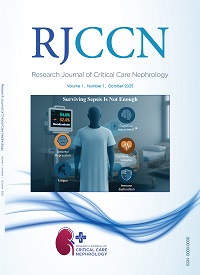Fluid Resuscitation in Sepsis and Septic Shock; What to Give and How Much to Give: A Systematic Review of Randomized Controlled Trials
DOI:
https://doi.org/10.60186/RJCCN.24Keywords:
sepsis, septic shock, fluid therapy, crystalloids, saline solution, albumins, resuscitation, vasoconstrictor agents, randomized controlled trialsAbstract
Introduction. The optimal composition and volume of intravenous
fluids for sepsis resuscitation remain uncertain. We conducted a
systematic review focused on two core questions: what fluid to
administer and how much to give in adult sepsis and septic shock.
Methods. We searched PubMed, Embase, Cochrane Library, and
ClinicalTrials.gov for randomized controlled trials published
from January 2020 to September 2025. Eligible trials enrolled
adults with sepsis or septic shock and compared either fluid
composition (e.g., balanced crystalloids, saline, albumin, plasma)
or resuscitation volume/strategy (restrictive versus liberal or
protocolized versus usual care). Two reviewers screened and
extracted data; risk of bias was assessed using RoB 2. Owing to
clinical heterogeneity and overlapping parent datasets, findings
were synthesized qualitatively.
Results. We identified contemporary multicenter RCTs and
prespecified or post hoc analyses spanning ED and ICU settings.
Balanced crystalloids consistently reduced hyperchloremic
acidosis and showed context-dependent signals for improved
short-term outcomes versus saline; absolute mortality effects were
modest. Albumin and plasma-based strategies produced transient
physiologic gains without durable outcome benefits. Large trials
comparing volume strategies (CLASSIC, CLOVERS) showed no
overall mortality difference despite approximately two liters less
fluid and earlier vasopressors in restrictive arms. Subgroup data
suggested advantage for restrictive, vasopressor-prioritized care
in advanced chronic kidney disease, while mechanistic sub-studies
demonstrated no adverse effects on cardiac strain or endothelial
glycocalyx. Feasibility trials targeting non-resuscitation fluids
reduced administered volumes without safety concerns.
Conclusions. Current randomized evidence supports balanced
crystalloids as default resuscitation fluids and indicates that
clinically guided restrictive strategies are generally as safe as
liberal ones, with potential benefit in fluid-intolerant phenotypes.
Effectiveness depends less on a fixed fluid or volume and more
on timing, patient context, and physiologic tolerance, reinforcing
the paradigm of precision fluid therapy.





